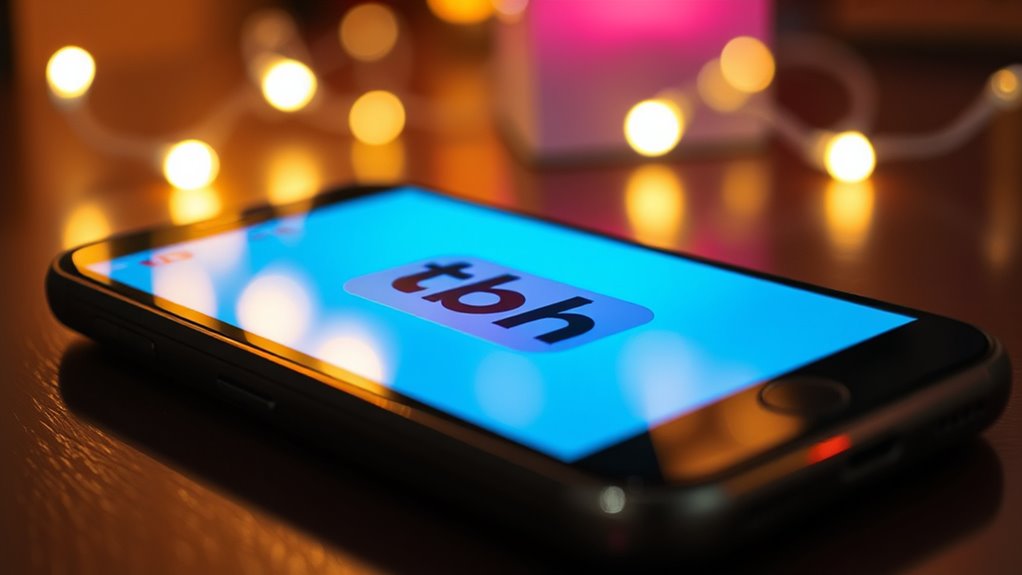TBH stands for “to be honest,” and it’s a popular online acronym used to express sincerity or candidness in digital conversations. You’ll often see it on social media or in chats when sharing honest opinions or thoughts. It helps promote genuine interactions and creates a sense of openness. As online slang evolves, TBH reflects the casual, authentic tone many people prefer today. To discover more about its origins and how to use it effectively, keep exploring!
Key Takeaways
- TBH stands for “to be honest,” an online abbreviation used to express honesty or genuine opinions.
- It originated in internet forums and social media, evolving from a simple phrase to a popular acronym.
- TBH is commonly used in conversations to preface sincere thoughts or feelings.
- Responding to TBH involves honest, respectful communication, often with a light or playful tone.
- Variations like TTYL, IMO, and TMI are related acronyms used for different social and conversational purposes.
The Origin and Evolution of TBH
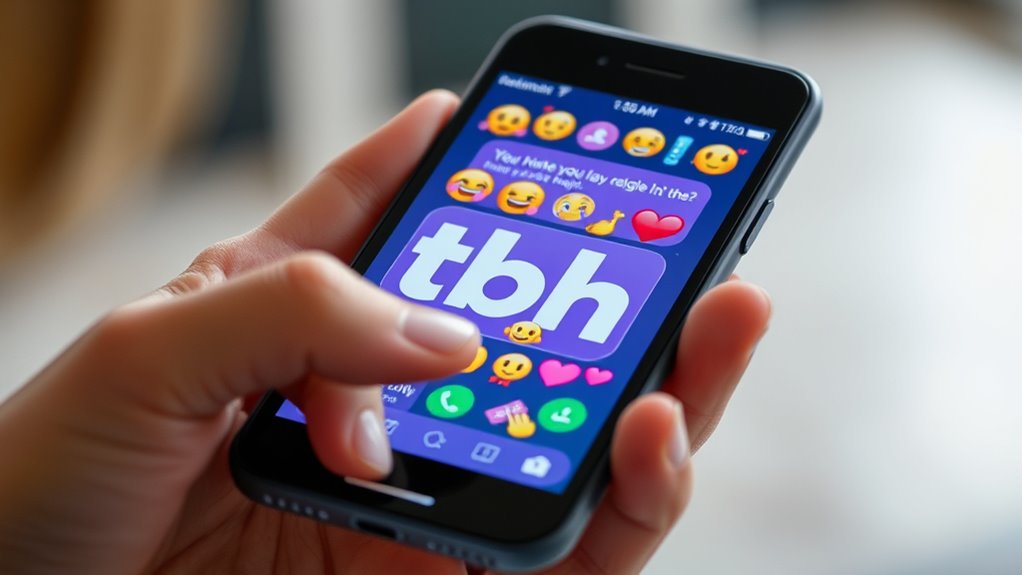
The phrase “TBH” started as an online abbreviation for “to be honest,” and it quickly gained popularity on social media platforms. Its history origins trace back to early internet forums and chat rooms, where users sought quick ways to express sincerity or candidness. Over time, TBH evolved linguistically, shifting from a simple phrase to a widely recognized acronym. Its linguistic evolution reflects how digital communication adapts language, making expressions more efficient and informal. As social media grew, TBH became a staple in online conversations, resonating with users who wanted to share honest opinions swiftly. Today, its popularity underscores how abbreviations like TBH have transformed digital language, demonstrating both the creativity and practicality of online communication. Additionally, this phenomenon exemplifies the broader linguistic evolution driven by online interactions and technological advancements.
Common Contexts Where TBH Is Used
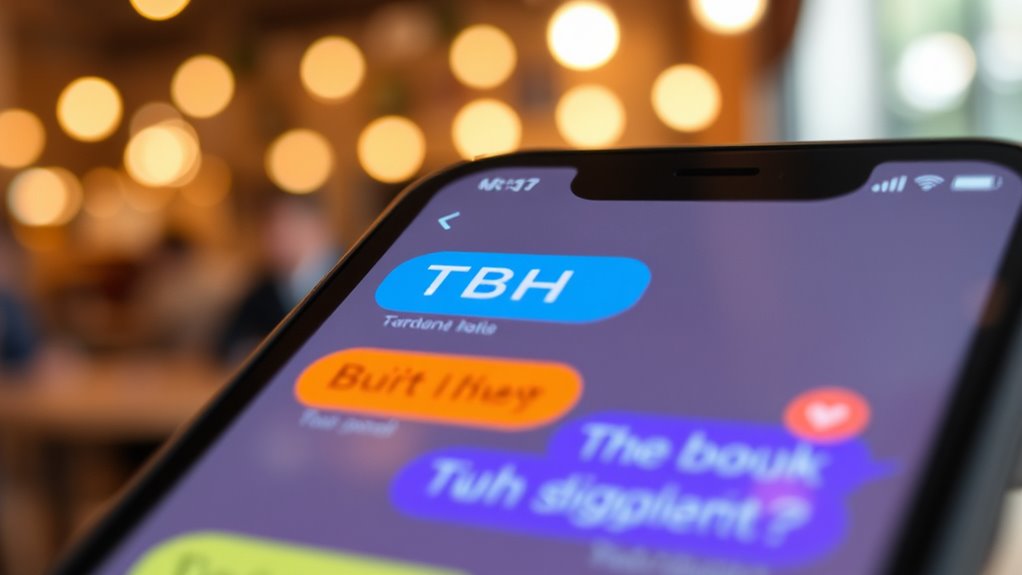
You’ll often see TBH used in conversations with friends to share honest opinions or feelings. It’s also common on social media when people want to express genuine thoughts or reactions publicly. Recognizing these contexts helps you understand when TBH is most likely to appear. Additionally, TBH can be used to preface a personal opinion, making the statement feel more candid and less formal.
Authentic Friend Interactions
Have you ever noticed friends using TBH during a casual chat? It’s often a way to encourage sincere, genuine conversations that strengthen your friendship. When someone says TBH, they’re inviting you to share heartfelt thoughts, which can promote personal development through open communication. These interactions typically happen in private messages or familiar group chats, where online privacy is respected and mutual trust is essential. Using TBH in this context helps friends connect on a deeper level, revealing feelings or opinions they might hesitate to share otherwise. It creates a safe space for honesty, fostering stronger bonds. So, next time you see TBH in a friend’s message, know they’re seeking authentic interaction that values transparency and respect. Additionally, embracing spiritual growth practices can help individuals develop the self-awareness necessary for genuine communication and connection.
Social Media Conversations
Ever wondered why TBH floods social media posts and comments? It’s because it encourages honesty and openness, fitting into casual conversations. People use TBH in social media to:
- Share genuine opinions without confrontation
- Connect authentically with friends
- Keep up with language evolution and slang trends
- Avoid privacy concerns by being selectively honest
- Reflect changing social media communication styles and the desire for authentic exchanges
Using TBH helps create a relaxed tone, but it also raises privacy concerns, as people sometimes reveal more than they mean. It’s a quick way to foster candid exchanges while adapting to changing communication styles. This abbreviation’s popularity reflects how social media conversations continually evolve, making interactions more informal and personal. TBH’s widespread use highlights the shift in language culture, blending authenticity with digital convenience.
How to Respond to a TBH Question

When someone asks you for a TBH, it’s best to be honest and respectful in your response. Keep things lighthearted to avoid any awkwardness, and feel free to share your genuine thoughts. This approach helps keep conversations fun and authentic. Additionally, understanding the context, such as camper conversions, can provide interesting insights into personal interests or lifestyle choices.
Be Honest and Respectful
Responding to a TBH (To Be Honest) question requires honesty combined with respect. Being truthful while maintaining online etiquette shows maturity and consideration. Here’s how you can do it:
- Keep your tone respectful, even if your answer is critical.
- Be genuine but avoid oversharing or hurtful comments.
- Consider relationship advice—focus on constructive feedback rather than criticism.
- Remember that your response reflects your character; choose words wisely.
- Be mindful of respectful communication to foster positive interactions and uphold kindness.
Keep Responses Lighthearted
Generally, keeping your responses lighthearted when answering a TBH question helps maintain a positive vibe and keeps the conversation enjoyable. When you respond with humor sharing, it makes the exchange feel more relaxed and approachable. Lighthearted replies help build trust because they show you’re comfortable and open without taking things too seriously. This clutter-free mindset can also make it easier to respond with humor and positivity. A playful tone can diffuse any awkwardness and make the interaction fun. Remember, the goal is to foster a friendly atmosphere where everyone feels comfortable. By staying positive and humorous, you create a space that promotes trust building and keeps conversations engaging.
Share Personal Thoughts
Sharing your personal thoughts in response to a TBH question can feel a bit nerve-wracking, but it’s a great way to build trust and deepen connections. When you’re open to personal reflection and emotional honesty, your response becomes more authentic. To do this effectively:
- Be genuine—share your true feelings without overthinking.
- Keep it concise but meaningful—avoid long-winded answers.
- Highlight positive traits or moments that show who you are.
- Respect your boundaries—only share what you’re comfortable with.
- Remember that practicing fraud detection techniques can help protect your personal information and maintain trust when sharing online.
Responding with honesty encourages others to do the same, creating a more meaningful exchange. Remember, your personal reflection can help strengthen your relationships and foster a sense of mutual understanding.
Variations and Similar Acronyms to TBH

There are several variations and similar acronyms to TBH that you might encounter in digital conversations. These reflect the online slang evolution and ongoing digital communication trends. Some common alternatives include:
| Acronym | Meaning | Usage Context |
|---|---|---|
| TTYL | Talk To You Later | Casual farewell |
| IMO | In My Opinion | Sharing personal views |
| FWIW | For What It’s Worth | Offering advice or info |
| IDK | I Don’t Know | Expressing uncertainty |
| TMI | Too Much Information | Over-sharing or discomfort |
These variations help keep conversations concise and adaptable across different social platforms, showcasing how online slang continues to evolve. Understanding these acronyms can enhance communication clarity and engagement in digital interactions.
Cultural Significance of TBH in Digital Communication

Have you ever wondered why TBH has become a staple in digital communication? Its cultural influence reflects how language evolves with technology, shaping interactions in meaningful ways. TBH fosters honesty and openness, encouraging genuine conversations. Its popularity highlights a shift towards informal, quick exchanges that mirror social media trends. Consider these points:
- It promotes authenticity, making conversations more personal.
- It reflects the casual tone embraced in online cultures.
- It influences new slang, blending tradition and innovation.
- It demonstrates how digital language adapts to foster connection.
– Additionally, the use of abbreviations like TBH can enhance communication efficiency by conveying sentiments swiftly and succinctly.
This acronym’s widespread use shows how language evolves to meet modern needs, reinforcing cultural shifts toward transparency and immediacy in communication. TBH isn’t just an abbreviation; it’s a mirror of digital society’s ongoing cultural influence.
Tips for Using TBH Appropriately

When using TBH, always consider the situation and the person you’re texting. You want to be truthful without crossing boundaries or hurting feelings. Keep your comments respectful to make sure your message is received positively. Being aware of appropriate language can help maintain good communication and avoid misunderstandings.
Context Matters When Using
Because the meaning of TBH can vary depending on the situation, it’s important to contemplate the context before using or interpreting it. In online slang and digital communication, TBH can convey honesty or admiration, but its tone depends on the setting. To use TBH effectively, consider these tips:
- Think about your relationship with the recipient—are you close or casual?
- Assess if the message’s tone matches the situation—serious, playful, or flirtatious.
- Avoid using TBH in sensitive conversations where honesty might hurt feelings.
- Recognize the platform—what works on social media may differ in direct messages.
- Remember that decoding slang involves understanding how different contexts can influence meaning and tone.
Understanding context helps ensure your intent is clear and prevents miscommunication in digital exchanges.
Keep It Respectful
Using TBH thoughtfully shows respect for others’ feelings and helps maintain positive conversations. When you use TBH, prioritize respectful communication by being honest without being hurtful. Remember that online etiquette matters; consider how your words might impact the person on the other end. Keep your tone friendly and constructive, avoiding sarcasm or negativity. If you’re unsure whether your comment might offend, ask yourself if it’s something you’d say face-to-face. Respectful communication fosters trust and keeps conversations healthy. Using TBH appropriately demonstrates maturity and kindness, encouraging open dialogue without crossing boundaries. By being mindful of your language, you create a safe space for honest sharing while maintaining respect for everyone involved. Additionally, understanding the best vacuums for dust removal in 2024 can help you create a cleaner environment that promotes healthier interactions.
The Role of TBH in Social Media Interactions
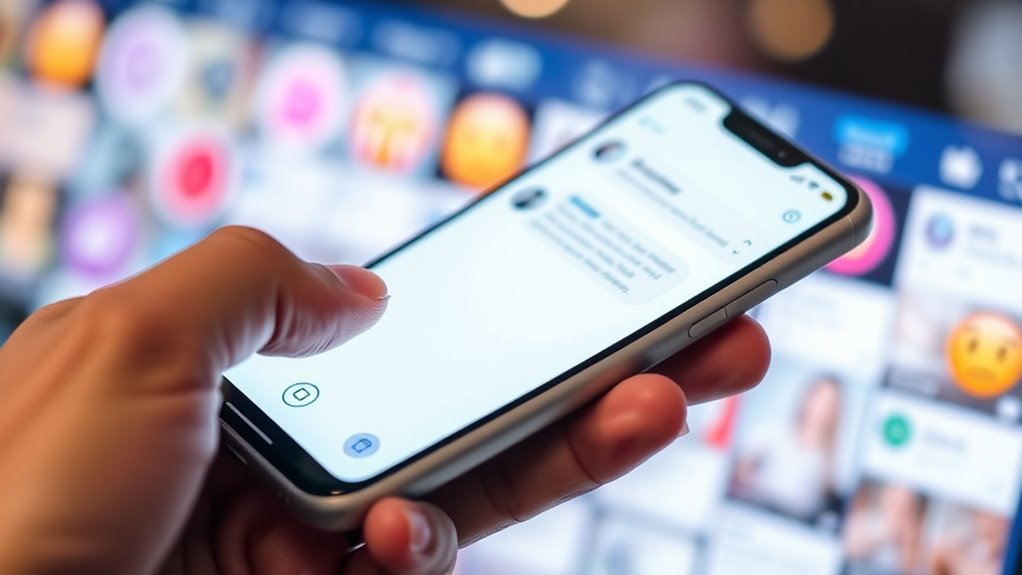
Have you ever noticed how TBH (to be honest) adds a personal touch to social media exchanges? It encourages honesty and openness, making interactions feel more genuine. However, using TBH also raises some concerns. Consider these points:
- Privacy concerns: When sharing honest opinions, you might reveal sensitive information unintentionally.
- Age appropriateness: Younger users may not fully grasp the implications of honesty online, risking inappropriate disclosures.
- Authenticity boost: TBH prompts users to express true feelings, strengthening connections.
- Risk of oversharing: The desire to be honest can lead to revealing too much, impacting personal boundaries.
- Understanding online behavior can help users strike a balance between honesty and privacy.
Differences Between TBH and Other Online Slang

While TBH (to be honest) emphasizes sincerity in online conversations, it differs from other slang terms that serve different social purposes. Some terms aim to flirt, joke, or express surprise, reflecting the online slang evolution driven by social media trends. Unlike “LOL” or “OMG,” which highlight reactions, TBH invites honest opinions about feelings or situations. Here’s a quick comparison: affiliate partnerships are often disclosed to promote transparency with audiences.
| Term | Purpose | Tone |
|---|---|---|
| TBH | Sincere honesty, personal insight | Genuine, open |
| LOL | Express laughter or amusement | Light, humorous |
| SMH | Disapproval or disbelief | Serious, emotional |
These differences shape how you communicate, making TBH unique in promoting authenticity amidst evolving social media trends.
Examples of TBH in Real-Life Conversations
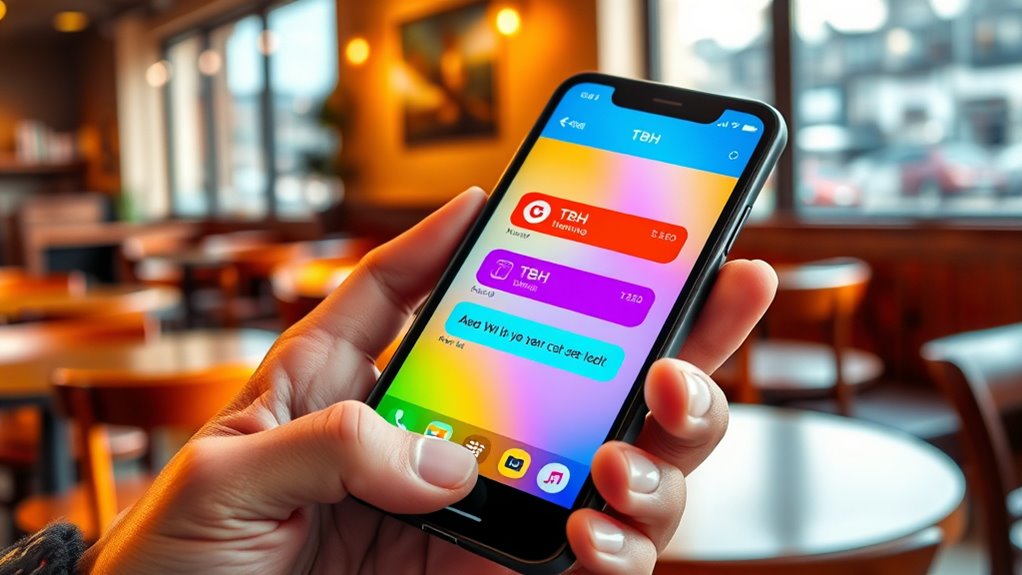
In everyday conversations, TBH often appears as a quick way to share honest opinions or feelings. It helps improve your communication skills by making conversations more authentic. Here are some real-life examples:
- During a chat with a friend about a movie, you might say, “TBH, I didn’t like the ending.”
- When discussing a new hobby, you could mention, “TBH, I’m still figuring it out.”
- In a group message about plans, you might state, “TBH, I’d prefer to stay home tonight.”
- After a workout, you could share, “TBH, I feel pretty tired but accomplished.”
- Incorporating honesty about your characteristics of a healthy breakfast can help you better understand your nutritional needs and preferences.
Using TBH in conversations fosters personal growth by encouraging honesty, which deepens connections and enhances your communication skills over time.
The Future of Acronyms Like TBH in Digital Language

As digital communication continues to evolve, acronyms like TBH are likely to remain relevant, but their form and usage may change. The trend of acronym evolution shows that new abbreviations emerge quickly, influenced by digital slang trends and the need for quick expression. Future acronyms might become more concise or integrate emojis and multimedia elements, blending text with visual cues. You’ll see some older abbreviations fade while others adapt to new platforms like voice messages or social media stories. As language adapts, you’ll find yourself using evolving slang that keeps conversations fresh and efficient. Staying current means understanding these shifts, recognizing that acronyms like TBH will continue to reflect the dynamic, fast-paced nature of digital language. Additionally, innovations in smart IoT technologies could lead to new ways of communicating visually or through automated responses.
Frequently Asked Questions
Can TBH Be Used in Formal or Professional Communication?
You shouldn’t use “tbh” in formal contexts or professional settings. It’s an informal abbreviation best suited for casual conversations with friends or on social media. In professional communication, clarity and professionalism matter, so avoid slang and abbreviations like “tbh.” Instead, express your thoughts clearly and politely, ensuring your message is appropriate for the setting. Using formal language helps you maintain credibility and respect in professional environments.
How Has the Usage of TBH Changed Over Recent Years?
You’ve probably noticed that TBH has become more casual and widespread over recent years. Its usage has evolved with social media trends, making it a common way to share honest opinions quickly. As slang evolves, people now use TBH more frequently in everyday conversations, often blending it into memes and captions. This shift reflects how digital communication continues to shape language, keeping it fresh, informal, and more expressive.
Are There Any Age Groups That Commonly Use TBH More Than Others?
You’ll notice that teens and young adults use TBH more often than older age groups, mainly because it’s popular in teen slang and social media trends. They use TBH to be honest or give genuine opinions, especially in casual chats. As social media evolves, younger users tend to embrace such abbreviations faster, making TBH a common part of their online conversations, unlike older generations who may stick to traditional language.
What Are Common Mistakes People Make When Using TBH?
When using TBH, you might misuse the abbreviation by overusing it or applying it in inappropriate situations, which can confuse your message. Additionally, you risk context misinterpretation if you don’t clarify what you’re being honest about or if the recipient isn’t familiar with the slang. To avoid these mistakes, guarantee your intent is clear and use TBH sparingly to keep your communication genuine and understandable.
Is TBH Considered Appropriate in All Online Communities?
Like a chameleon changing with its surroundings, TBH isn’t always appropriate across all online communities. Cultural acceptance and platform differences influence its use; in some spaces, it’s welcomed as casual, while others see it as too informal. Always observe the tone and norms of each community. If unsure, opt for more neutral language—respecting the unique culture of each platform guarantees your message fits in seamlessly.
Conclusion
Now that you understand what TBH means and how it’s used, imagine the conversations it could spark. Will it bring you closer to friends or spark new connections? As digital slang continues to evolve, TBH remains a powerful tool to share honesty and build trust. Stay curious about the language of tomorrow—because the words you’ll use next might just change the way you see the world. Are you ready to explore what’s next?
